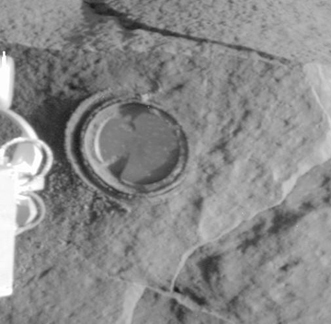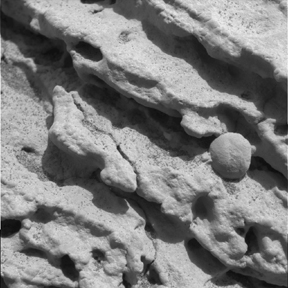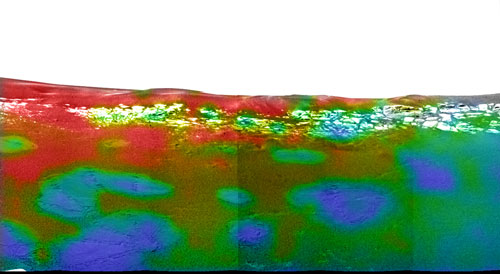Geotimes

Web Extra
Wednesday, February 11, 2004
Mars update: A pixel at a time
The two rovers on Mars are on the move. Spirit, after 10-day lapse in memory,
now functions again after efforts by Jet Propulsion Lab (JPL) scientists. Its
twin explorer, Opportunity, has been traveling in its own crater, halfway around
the planet.
 Some noteworthy milestones
include the first "artificial" hole drilled on the planet. Spirit
used its rock-abrasion tool, perched on its robot arm, to drill a hole into
a chunk of rock in order to examine the fresh unweathered stone beneath. Spirit's
further instrumental examinations confirmed that the rock was volcanic. (See
links below.)
Some noteworthy milestones
include the first "artificial" hole drilled on the planet. Spirit
used its rock-abrasion tool, perched on its robot arm, to drill a hole into
a chunk of rock in order to examine the fresh unweathered stone beneath. Spirit's
further instrumental examinations confirmed that the rock was volcanic. (See
links below.)
The first drill hole on Mars, shown here
in process, is more of a shallow depression, made by the rover Spirit's rock
abrasion tool. The ground spot is 45.5 millimeters (1.8 inches) in diameter
and 2.65 millimeters (0.1 inch) deep, made Feb. 6, 2004. Image courtesy of NASA/JPL/Cornell.
 Closer inspection by Opportunity
of a rock in its home crater revealed bedded sand layers containing tiny
rounded nodules. JPL scientists have hypothesized that these nodules could
be concretions from water flowing through the sediments and depositing minerals.
Alternatively, they may be volcanic "teardrops" that were pyroclastically
distributed and now float in the sand grain matrix. Earlier, Opportunity saw
similar rounded pebbles in soil near its landing site. Its first images of the
soil also indicated hematite-rich soil at the surface, a possible indication
of the presence of water (click here for images below).
Closer inspection by Opportunity
of a rock in its home crater revealed bedded sand layers containing tiny
rounded nodules. JPL scientists have hypothesized that these nodules could
be concretions from water flowing through the sediments and depositing minerals.
Alternatively, they may be volcanic "teardrops" that were pyroclastically
distributed and now float in the sand grain matrix. Earlier, Opportunity saw
similar rounded pebbles in soil near its landing site. Its first images of the
soil also indicated hematite-rich soil at the surface, a possible indication
of the presence of water (click here for images below).
Opportunity detected the hematite using its thermal emissions spectrometer,
one way it has of "seeing" Mars' surface. But how the rovers "see"
color is different than humans do. The rovers' cameras capture the martian surface
in black and white. It is the scientists back home who assign color values to
the images for the world to see in "true color."
Of the 11 lenses on the rovers' panoramic cameras, three are dedicated to red,
green and blue wavelengths. The rest record reflections from surfaces at different
wavelength ranges, in order to find different reflectance properties (for example,
olivine and pyroxene absorb light at the one-micrometer wavelength because of
their iron content). The filters, set on the two adjacent lenses of the camera,
range from the 450- to 980-nanometer wavelengths. Two of the lenses are dedicated
to watching the Sun, and one is clear.
The camera sits about 1.3 meters above the ground, for a human's eye view,
and it can send back image swaths that are 1024 by 1024 pixels. The rovers send
their photos back in pixel batches, which are sometimes garbled. Back on Earth,
computers overlay and correct the red, green and blue lens views, according
to the original color chips that Cornell scientists placed on the rovers, in
order to approximate landscape images as a human eye might see them.
Despite the flood of new sightings and findings, the rovers still have a way
to go. Yesterday, NASA announced that the Spirit demonstrated it could navigate
on its own, using software that programs it to avoid obstacles and direct towards
a specified goal. The rover moved almost half a dozen meters, while Opportunity
negotiated a little more than 4 meters of its home crater's rim, shooting pictures
as it rolled.
That distance may not seem like much, but it will take weeks for the rovers
to traverse the Mars landscape in order to reach their study targets, some of
which may only be meters away.
Naomi Lubick
Links:
"Rat
Crumbs," NASA press release on Spirit's first drill hole in Mars rock
"Mars
rover pictures raise 'blueberry muffin' questions," NASA press release
on Opportunity's tiny rounded nodules
"Revealing
Mars' true colors," JPL NASA Web site feature story
"What
color is Mars, really?" from The Above Top Secret News Network online
discussion board (page 5)
More
about the Panoramic Camera at the Cornell University research group's site
Images:
 |
A magnified image taken of soil
near the Opportunity's landing site, Meridiani Planum. Coarse grains on
the scale of millimeters rest on fine sand; the image is 3 centimeters
(1.2 inches) across. These pebbles may be cooled lava droplets or accreted
nodules. Image courtesy of NASA/JPL/US Geological Survey.
|
| Opportunity used its thermal emissions
spectrometer to detect concentrations of crystalline hematite, which is
high in the red and orange and low in the blue and green patches. The lander's
airbag left bounce marks that lacked hematite. Image courtesy of NASA/JPL/Arizona
State University/Cornell. |

|
Back to top
 Some noteworthy milestones
include the first "artificial" hole drilled on the planet. Spirit
used its rock-abrasion tool, perched on its robot arm, to drill a hole into
a chunk of rock in order to examine the fresh unweathered stone beneath. Spirit's
further instrumental examinations confirmed that the rock was volcanic. (See
links below.)
Some noteworthy milestones
include the first "artificial" hole drilled on the planet. Spirit
used its rock-abrasion tool, perched on its robot arm, to drill a hole into
a chunk of rock in order to examine the fresh unweathered stone beneath. Spirit's
further instrumental examinations confirmed that the rock was volcanic. (See
links below.)
 Closer inspection by Opportunity
of a rock in its home crater revealed bedded sand layers containing
Closer inspection by Opportunity
of a rock in its home crater revealed bedded sand layers containing 

